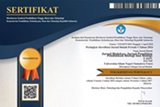The potential of pineapple peel waste fermentation as antibacterial and antioxidant agents
Abstract
Keywords
Full Text:
PDFReferences
Arimba, G. P., Jasman, Hasanuddin, & Syahrul. (2019). Pemurnian Bioetanol Limbah Kulit Nanas Menggunakan Alat Distilasi Sederhana Model Kolom Refluks. Jurnal Zarah, 7(1), 22–28. https://doi.org/10.31629/zarah.v7i1.1173
Arun, C., & Sivashanmugam, P. (2015a). Identification and optimization of parameters for the semi-continuous production of garbage enzyme from pre-consumer organic waste by green RP-HPLC method. Waste Management, 44, 28–33. https://doi.org/https://doi.org/10.1016/j.wasman.2015.07.010
Arun, C., & Sivashanmugam, P. (2015b). Investigation of biocatalytic potential of garbage enzyme and its influence on stabilization of industrial waste activated sludge. Process Safety and Environmental Protection, 94(C), 471–478. https://doi.org/10.1016/j.psep.2014.10.008
Cerda-Cejudo, N. D., Buenrostro-Figueroa, J. J., Sepúlveda-Torre, L., Torres-León, C., Chávez-González, M. L., Ascacio-Valdés, J. A., & Aguilar, C. N. (2023). Solid-State Fermentation for the Recovery of Phenolic Compounds from Agro-Wastes. Resources, 12(3). https://doi.org/10.3390/resources12030036
Davis, W., Stout T. (1971). Disc Plate Method of Microbiological Antibiotic Assay, Appl Microbiol, 22(4), 659–65.
Evstigneeva, S. S., Telesheva, E. M., Mokeev, D. I., Borisov, I. V., Petrova, L. P., & Shelud’ko, A. V. (2021). Response of Bacteria to Mechanical Stimuli. Microbiology (Russian Federation), 90(5), 558–568. https://doi.org/10.1134/S0026261721050052
Farma, S. A., Handayani, D., Putri, I. L. E., & Putri, D. H. (2021). Pemanfaatan Sisa Buah dan Sayur sebagai Produk ECOBY Ecoenzyme di Kampus Universitas Negeri Padang. Suluah Bendang: Jurnal Ilmiah Pengabdian Kepada Masyarakat, 21(2), 81. https://doi.org/10.24036/sb.01180
Ginting, N., & Prayitno, L. (2022). Dilution of Eco Enzyme and Antimicrobial Activity Against Staphylococcus aureus Animal Production Study Program , Faculty of Agriculture , Universitas Sumatera Utara , Padang. https://doi.org/10.33772/jitro.v9i1.19705
Gumilar, G. G. (2023). Ecoenzyme Production, Characteristics, and Applications: A Review. Jurnal Kartika Kimia, 6(1), 45–59. https://doi.org/10.26874/jkk.v6i1.186
Halstead, F. D., Rauf, M., Moiemen, N. S., Bamford, A., Wearn, C. M., Fraise, A. P., Lund, P. A., Oppenheim, B. A., & Webber, M. A. (2015). The antibacterial activity of acetic acid against biofilm-producing pathogens of relevance to burns patients. PLoS ONE, 10(9), 1–15. https://doi.org/10.1371/journal.pone.0136190
Hayati, W. L. (2023). A Study on the Content of Eco Enzyme from Pineapple Peel (Ananas comosus L.) and Watermelon (Citrullus lanatus). DIVERSITAS HAYATI: Journal of Conservation and Biological Resources, 01(02), 7–17.
Hermawan, W., & Madyasti, F. S. (2023). Pemanfaatan Limbah Buah Dan Sayur Sebagai Ecoenzyme Alternatif Pestisida Sintetik Di Desa Sukapura, Kecamatan Kertasari, Kabupaten Bandung. Dharmakarya, 12(1), 71. https://doi.org/10.24198/dharmakarya.v11i2.36174
Husniah, I., & Gunata, A. F. (2020). Ekstrak Kulit Nanas sebagai Antibakteri. Jurnal Penelitian Perawat Profesional, 2(1), 85–90. https://doi.org/10.37287/jppp.v2i1.51
Knapp, J. L. A., González-Pinzón, R., & Haggerty, R. (2018). The Resazurin-Resorufin System: Insights From a Decade of “Smart” Tracer Development for Hydrologic Applications. Water Resources Research, 54(9), 6877–6889. https://doi.org/10.1029/2018WR023103
Lestari, G., & Fitri, R.D. (2019). Uji Daya Hambat Ekstrak Buah Nanas (Annas comosus L.) terhadap Bakteri Escherichia coli. Jurnal Ilmiah Farmacy, 6(1), 57–66.
Lund, P., Tramonti, A., & De Biase, D. (2014). Coping with low pH: Molecular strategies in neutralophilic bacteria. FEMS Microbiology Reviews, 38(6), 1091–1125. https://doi.org/10.1111/1574-6976.12076
Mavani, H. A. K., Tew, I. M., Wong, L., Yew, H. Z., Mahyuddin, A., Ghazali, R. A., & Pow, E. H. N. (2020). Antimicrobial efficacy of fruit peels eco-enzyme against Enterococcus faecalis: An in vitro study. International Journal of Environmental Research and Public Health, 17(14), 1–12. https://doi.org/10.3390/ijerph17145107
Natasya, N., Fadilah, M., Fitri, R., Farma, S. A., Raharjeng, A. R. P., & Simwela, M. (2023). Analysis of Eco-enzyme Quality Based on Differences in Plant Tissue. Jurnal Biota, 9(1), 45–53. https://doi.org/10.19109/biota.v9i1.13166
Neupane, K., & Khadka, R. (2019). Production of Garbage Enzyme from Different Fruit and Vegetable Wastes and Evaluation of its Enzymatic and Antimicrobial Efficacy. Tribhuvan University Journal of Microbiology, 6(1), 113–118. https://doi.org/10.3126/tujm.v6i0.26594
Ningrum, R. S., Karima, R., Renjana, E., Ramadani, A. H., Umarudin, U., Istiqomah, N., & Aminingsih, T. (2024). Investigation of Eco-enzyme from Pineapple (Ananas comosus (L.) Merr.) Waste: Chemical Composition, Antibacterial Activity, and Molecular Docking Approach. Waste and Biomass Valorization, 15(8), 4793–4805. https://doi.org/10.1007/s12649-024-02492-6
Ningsih, A. P., Samosir, A. G. M., & Hidayatullah, B. S. (2023). Production of Eco-Enzymes From Fruit Peel Waste As an Effort To Address Organic Waste Management Issues in Indonesia. Jbio : Jurnal Biosains, 9(2), 93–100.
Ortega-Hernández, E., Martinez-Alvarado, L., Acosta-Estrada, B. A., & Antunes-Ricardo, M. (2023). Solid-State Fermented Pineapple Peel: A Novel Food Ingredient with Antioxidant and Anti-Inflammatory Properties. Foods, 12(22). https://doi.org/10.3390/foods12224162
Permatananda, P. A. N. K., I Gde Suranaya Pandit, Putu Nita Cahyawati, & Anak Agung Sri Agung Aryastuti. (2023). Antimicrobial Properties of Eco Enzyme: A Literature Review. Bioscientia Medicina : Journal of Biomedicine and Translational Research, 7(6), 3370–3376. https://doi.org/10.37275/bsm.v7i6.831
Prasetyo, H. I., Wijana, G., Ayu, I., & Darmawati, P. (2023). Inventarisasi dan Karakterisasi Morfologi dan Agronomi Tanaman Nanas ( Ananas comosus ( L .) Merr ) pada Beberapa Sentra Produksi di Pulau Jawa , Indonesia. 6(2), 405–412.
Putri, D. A., Fahmi, N. F., Mawli, R. E., & Fatmawati, S. (2024). Antibacterial potential of Nicotiana tabacum leaves extracts and their antioxidant activities. al Kimiya: Jurnal Ilmu Kimia dan Terapan, 11(2), 112-121. https://doi.org/10.15575/ak.v11i2.39227
Putri, D. A., Ulfi, A., Purnomo, A. S., & Fatmawati, S. (2018). Antioxidant and antibacterial activities of Ananas comosus peel extracts. Malaysian Journal of Fundamental and Applied Sciences, 14(2), 307–311. https://doi.org/10.1111/j.1365-2621.2003.tb09669.x
Rivera, A. M. P., Toro, C. R., Londoño, L., Bolivar, G., Ascacio, J. A., & Aguilar, C. N. (2023). Bioprocessing of pineapple waste biomass for sustainable production of bioactive compounds with high antioxidant activity. Journal of Food Measurement and Characterization, 17(1), 586–606. https://doi.org/10.1007/s11694-022-01627-4
Roy, S., & Lingampeta, P. (2014). Solid Wastes of Fruits Peels As Source of Low Cost Broad Spectrum Natural Antimicrobial Compounds- Furanone, Furfural and Benezenetriol. International Journal of Research in Engineering and Technology, 03(07), 273–279. https://doi.org/10.15623/ijret.2014.0307046
Saleem, M., & Saeed, M. T. (2020). Potential application of waste fruit peels (orange, yellow lemon and banana) as wide range natural antimicrobial agent. Journal of King Saud University - Science, 32(1), 805–810. https://doi.org/10.1016/j.jksus.2019.02.013
Sembiring, B. M., & Sari, H. (2021). Efektivitas Pemberian The Kulit Nenas Terhadap Tekanan Darah Lansia Penderita Hipertensi. 4(2), 250–255.
Srivastava, N., Srivastava, M., Ramteke, P. W., & Mishra, P. K. (2019). Chapter 23 - Solid-State Fermentation Strategy for Microbial Metabolites Production: An Overview. In V. K. Gupta & A. Pandey (Eds.), New and Future Developments in Microbial Biotechnology and Bioengineering (pp. 345–354). Elsevier. https://doi.org/https://doi.org/10.1016/B978-0-444-63504-4.00023-2
Tallei, T. E., Fatimawali, Niode, N. J., Alsaihati, W. M., Salaki, C. L., Alissa, M., Kamagi, M., & Rabaan, A. A. (2023). Antibacterial and Antioxidant Activity of Ecoenzyme Solution Prepared from Papaya, Pineapple, and Kasturi Orange Fruits: Experimental and Molecular Docking Studies. Journal of Food Processing and Preservation, 2023. https://doi.org/10.1155/2023/5826420
Viza, R. Y. (2022). Uji Organoleptik Eco-Enzyme dari Limbah Kulit Buah. BIOEDUSAINS:Jurnal Pendidikan Biologi Dan Sains, 5(1), 24–30. https://doi.org/10.31539/bioedusains.v5i1.3387
DOI: http://dx.doi.org/10.30821/biolokus.v8i1.3887
Refbacks
- There are currently no refbacks.
Copyright (c) 2025 Jurnal Biolokus: Jurnal Penelitian Pendidikan Biologi dan Biologi
indexed by :












